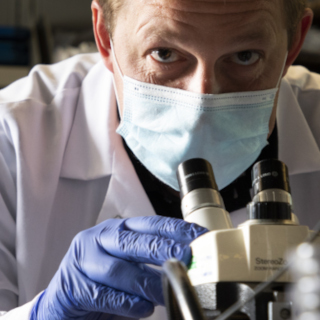Baytril Administration
Last Review Date: August 25, 2020
I. Purpose/Scope
The purpose of this Standard Operating Procedure (SOP) is to outline the dosing and administration of antibiotic Baytril™ (enrofloxacin). The administration of ANY treatments must be performed in consultation with the Attending Veterinarian. All medications delivered in food or water must be clearly identified with the treatment that is being administered. All drugs used in animals must be in date.
II. Policy
It is LAR policy to meet or exceed all federal, state, and local regulations and guidelines and to comply with all institutional policies and procedures as they apply to the use of animals in research. Personnel must attend any applicable training in animal care and use, occupational health and safety, equipment operation, and SOPs prior to performing activities outlined in this SOP or work under the direct supervision of trained personnel.
III. Rats
A. SQ Injection. Signalment: 5-10 mg/kg SQ every 12 hours for 10 days (unless otherwise
directed by the AV)
1. Dilution
a. Concentration: 1:10 dilution = 2.27 mg/ml (undiluted = 22.7 mg/kg)
b. Obtain an empty, sterile vial
c. Check that the parent vial of Baytril™ (22.7mg/ml) is not expired and
d. Clean port of vial with alcohol prior to each withdrawal.
e. Withdraw 1 cc of Baytril™ and instill into the empty, sterile vial.
f. Withdraw 9
above).
g.
h. Label the vial with the drug name, concentration and date mixed
2. Administration. Administer the Baytril™ as per the chart below
|
Body Weight (grams) |
5.0 mg/kg Dose Injection Volume (ml) SQ |
10.0 mg/kg Dose Injection Volume (ml) SQ |
|
150 g |
0.33 ml |
0.66 ml |
|
200 g |
0.44 ml |
0.88 ml |
|
250 g |
0.55 ml |
1.10 ml |
|
300 g |
0.70 ml |
1.30 ml |
|
350 g |
0.80 ml |
1.50 ml |
|
400 g |
0.88 ml |
1.80 ml |
|
450 g |
1.00 ml |
2.00 ml |
|
500 g |
1.10 ml |
2.20 ml |
|
550 g |
1.20 ml |
2.40 ml |
B. Drinking Water
1. Preparation: Add 1.9 ml of 22.7 mg/ml Baytril™ to 250 ml of drinking water (8 oz.
bottle) or 3.7 ml to a 500 ml bottle of drinking water (16 oz. bottle).
a. Baytril™ may be administered via drinking water
b. Water must not be chlorinated or acidified (inactivates the drug)
c. Baytril™ has a bitter taste. This bitter taste in combination with an ill animal
may decrease the volume of water consumed and prevent therapeutic
blood levels of the antibiotic from being reached
d. Fruit juice (5-10 ml) or a packet of Splenda may be added to the water bottle
to improve palatability
e. Medicated drinking water must be changed weekly or if it gets cloudy
IV. Degu
Dose as per the rats (above) for injection or oral administration in drinking water
V. Mice
A. SQ Injection: Signalment: 5 mg/kg SQ every 12 hours for 10 days (unless otherwise
directed by the AV.
1. Dilution: 1:10 dilution = 2.27 mg/ml (undiluted = 22.7 mg/kg)
a. Obtain an empty, sterile vial
b. Check that the parent vial of Baytril™ (22.7mg/ml) is not expired and
c. Clean port of vial with alcohol prior to each withdrawal.
d. Withdraw 1
e. Withdraw 9
above).
f.
g. Label the vial with the drug name, concentration and date mixed
2. Administer. Administer the Baytril™ as per the chart below
|
Body Weight (grams) |
5.0 mg/kg Dose Injection Volume (ml) SQ |
|
15 g |
0.03 ml |
|
20 g |
0.04 ml |
|
25 g |
0.06 ml |
|
30 g |
0.07 ml |
|
35 g |
0.08 ml |
|
40 g |
0.09 ml |
|
45 g |
0.10 ml |
B. Drinking Water
1. Preparation: Add 1.9 ml of 22.7 mg/ml Baytril™ to 250 ml of drinking water (8 oz.
bottle) or 3.7 ml to a 500 ml bottle of drinking water (16 oz. bottle)
2. Administration
a. Baytril™ may be administered via drinking water
b. Water must not be chlorinated or acidified (inactivates the drug)
c. Baytril™ has a bitter taste. This bitter taste in combination with an ill animal
may decrease the volume of water consumed and prevent therapeutic
blood levels of the antibiotic from being reached
d. Fruit juice (5-10 ml) or a packet of Splenda may be added to the water bottle
to improve palatability
e. Medicated drinking water must be changed weekly or if it gets cloudy
Reference: Antibiotic Administration in the Drinking Water of Mice
VI. Snowshoe Hares and Rabbits
A. Drinking Water
1. Administration. Signalment: 10 mg/kg in water for 10 days
a. Check that the parent vial of Baytril™ (100 mg/ml) is not expired and the
solution has not changed
b. Clean the port of the parent vial of Baytril™ with alcohol prior to withdrawal
c. Withdraw 2.0 cc of 100 mg/ml Baytril™ and place in a 1-liter water bottle
d. Water must not be chlorinated or acidified (inactivates the drug)
e. Baytril™ has a bitter taste causing an ill animal to decrease the volume of
water consumed and prevent therapeutic blood levels of the antibiotic from
being reached.
f. Fruit juice (5-10 ml) or a packet of Splenda may be added to the water bottle
to improve palatability.
g. Medicated drinking water must be changed weekly or if it gets cloudy
B. SC Injection
1. Injection. Signalment: 15 mg/kg subcutaneously twice a day for 10 days
a. Check that the parent vial of Baytril™ (100 mg/ml) is not expired and the
solution has not changed
b. Clean the port of the parent vial of Baytril™ with alcohol prior to withdrawal
c. Withdraw the calculated dose from the Baytril™ vial
d. Administer subcutaneously
